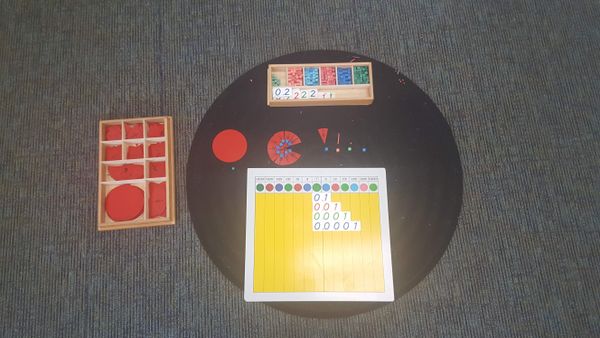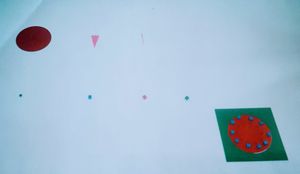Decimals Introduction Lesson 1
From wikisori
Contents
Age
9-12
Materials
- Fraction insets: the whole circle, circle divided into tenths
- Cardboard or construction paper sector of the circle: 1/10 (you will need to trace a 1/10 sector ahead of time)
- Scissors
- One green unit bead in small dish
- Box of decimal material: red, blue, green beads for whole numbers and red, blue, green discs (light and dark of each color) for decimal numbers
Preparation
Students should have a comfortable knowledge of fractions and the definition that a fraction is an equal part of a whole (a fraction is the result of dividing a whole).
Presentation
- 1. Take out the whole circle, and ask the student what its value is(It represent on whole). Show the green unit bead- It also represents on whole. "Both have the same value- one unit."
- 2. "If we divide the circle into ten equal parts, we have this." (Show the circle divided into tenths). "Each of the small sectors is 1/10 of the whole circle. Ten of these tenths equal one whole."
- 3. Gather 10 blue disks and hide them in one hand. "I'm going to perform magic. I will take this unit bead (green) and make ten pieces." Hold the unit bead between your fingers next to the hand holding the 10 discs. "If I were to split this unit into ten equal pieces, I would have this..." (be as dramatic as you feel comfortable, squeezing the unit bead, slowly moving it close to your wrist and then open your fist allowing the 10 discs to fall onto the presentation rug or desk. Pick up one disk and say, "This represents one tenth of the unit bead. Ten of these disks equal one whole."
- 4. Place the small blue disks on the sectors of the divided circle. "Each has the same value: the sector 1/10 and the blue disk."
- 5. Take the cardboard or construction paper sector that you prepared for 1/10 and cut off a thin piece saying, "If I were to cut this tenth into ten equal pieces, each piece would be 1/100 of the whole." (You can stop there or continue trying to cut the 1/10 sector into 10 equal strips.It's extremely difficult, but I have found that the students are engaged, and the impression of making one tenth into ten hundredths forms a clear understanding of how decimals are smaller forms of a whole.)
While holding one of the hundredth strips say, "If I take this blue disk, this tenth and do the same; if I smash it into ten pieces, each will have the value of one hundredth of the whole."
- 6. Review by displaying the circle, bead, sectors and disks in a display with the unit on the left and tenth and hundredth to the right. (You can choose to have the students record this image in their Math journals.)
- 7. If you chose to cut 10 pieces of the 1/10 sector, pick up one of them or cut a strip from the 1/10 sector to represent one hundredth and say, "If I were to cut this hundredth into ten equal pieces, each piece will have the value of 1/1000 (Again, I choose to try to cut 10 equal pieces and then pull out one of them) . Hold the hundredth disc (red) and then say, "In the same way, if I were to break this hundredth disk into ten equal pieces, each piece will have the value of one thousandth." Show the green thousandth disk.
- 8. With the final display in front of you, review the names of units, tenths, hundredths, and thousandths (you can choose to create labels with names to place under the discs). Review how many tenths equal a unit, how many hundredths equal a tenth and so on. The teacher can do this by conducting the Montessori Three Period Lesson.
DEPENDING ON TIME AND THE ENERGY OF YOUR STUDENTS, YOU CAN CHOOSE TO STOP HERE OR INTRODUCE THE NUMERIC SYMBOLS:
Materials: whole number and decimal numeric symbol cards/tablets Presentation:
- 1. Show the card for 10. "This is ten. If I turn it upside down and add a decimal point, it is no longer a ten, but a tenth." Show the 0.1 tablet.
- 2. Show the card for 100. "This is a hundred. If I turn it upside down and add a decimal point, it is no loner a hundred, but a hundredth." Show the 0.01 tablet.
- 3. Show the card for 1,000. "This is a thousand. If I turn it upside down and add a decimal point, it is no longer a thousand but a thousandth." Show the 0.001 tablet.
Control Of Error
Teacher guided.
Points Of Interest
dec is the root to the Latin word for ten- decem
Purpose
- To make a visual, auditory and kinesthetic impression upon the child on how whole numbers are divided into smaller units-decimals.
Variation
The contributor of this lesson introduces the numerals at the same time she cuts the fraction pieces apart.
Handouts/Attachment


